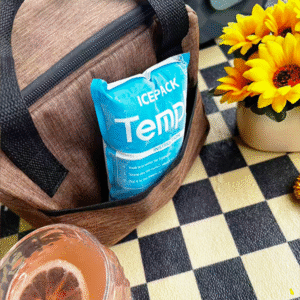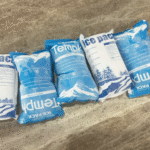Shipping temperature-sensitive products, from pharmaceuticals to perishable foods, demands robust cold chain solutions. Dry ice packs have become an essential component in cold chain logistics due to their ability to maintain ultra-cold temperatures without water leakage. This guide explores how dry ice packs optimize logistics operations and addresses emerging trends for 2025. We will cover best practices, the benefits of dry ice over traditional ice, and innovations in the field, helping you stay compliant with industry standards and improve efficiency.

What Are Dry Ice Packs and Why Are They Essential for Cold Chain Logistics?
Dry ice packs are solid carbon dioxide (CO₂) that sublimate at −78.5°C (−109.3°F), providing an extremely cold temperature without the typical mess of melting ice. This unique sublimation process allows them to keep products cold for longer periods, ensuring the integrity of temperature-sensitive shipments like pharmaceuticals, food, and biological samples. Dry ice packs are indispensable because they prevent water damage, an issue that can arise with traditional ice, and they maintain consistent temperatures throughout long shipments.
Key Takeaways:
-
Why dry ice packs are a critical solution for cold chain logistics
-
How to choose the right dry ice pack for your shipment needs
-
The advantages of using dry ice over traditional ice in cold chain operations
-
Best practices for dry ice packaging and shipping
-
Emerging trends in cold chain logistics for 2025
How to Choose the Right Dry Ice Pack for Your Shipment?
Factors to Consider for Dry Ice Pack Selection
When selecting dry ice packs for shipping, various factors must be considered:
-
Temperature Sensitivity: Different products require different temperature ranges. For instance, pharmaceuticals and vaccines often need ultra-low temperatures, and dry ice is ideal for such sensitive shipments.
-
Shipment Duration: The longer the shipment, the more dry ice you will need. A general guideline is 1-2 pounds of dry ice per 24 hours for shorter shipments, and more for longer ones.
-
Size and Weight of Shipment: Larger shipments require more dry ice. It is essential to calculate the right quantity to ensure the shipment maintains the required temperature.
| Shipment Type | Recommended Dry Ice Amount | Shipping Duration | Temperature Range |
|---|---|---|---|
| Pharmaceutical Shipments | 5–10 lbs per 24 hours | 24–72 hours | -20°C to -70°C |
| Seafood Shipments | 1–2 lbs per 24 hours | 24 hours | -18°C to -20°C |
| Biotech Samples | 5 lbs per 24 hours | 48 hours | -20°C to -50°C |
| Food Deliveries | 2–3 lbs per 24 hours | 24 hours | -10°C to -18°C |
What Are the Benefits of Using Dry Ice Over Traditional Ice in Cold Chain Logistics?
Extended Cooling Duration
Dry ice stays colder for significantly longer than traditional ice, making it ideal for shipments that need to stay cool for extended periods. Unlike regular ice, which melts and requires frequent replenishment, dry ice can keep goods at their required temperature throughout long shipping times.
No Water Leakage
A significant advantage of dry ice is its ability to sublimate directly into gas, avoiding the water leakage issue that often occurs with traditional ice. This is especially critical when shipping delicate products such as biotechnology samples and pharmaceuticals, where any water contact can damage the goods.
Temperature Control Below Freezing
For products that require temperatures below freezing, dry ice is often the only feasible option. It is ideal for ultra-low temperature preservation, providing reliable cooling for extended durations. This makes it essential for industries like biotechnology and pharmaceuticals, where temperature control is critical to product efficacy.
Best Practices for Packaging and Shipping with Dry Ice Packs
To optimize the effectiveness of dry ice packs in cold chain logistics, follow these best practices:
Use Insulated Containers
Proper insulation helps maintain the cold temperature inside the container and slows the sublimation process. For short-term shipments, foam coolers or insulated boxes are suitable. For longer shipments, advanced vacuum-insulated containers offer superior thermal protection, helping to extend cooling duration.
Layer Dry Ice Properly
Dry ice should be placed at the bottom of the container. This ensures that the cold air rises and efficiently cools the products. It’s essential to leave room for CO₂ gas to escape to avoid any pressure buildup within the container.
Monitor Temperature During Transit
Using IoT-enabled temperature sensors allows real-time monitoring of the shipment’s temperature. This ensures that any temperature fluctuations are immediately addressed, preventing spoilage and ensuring compliance with regulatory temperature requirements.
2025 Trends in Cold Chain Logistics
Smart Packaging and IoT Sensors
In 2025, cold chain logistics is being transformed by advancements in smart packaging. IoT sensors integrated with dry ice packs provide real-time data on temperature, humidity, and location, ensuring that shipments remain within the desired temperature range. These technologies are reducing the risk of spoilage and improving efficiency, particularly in long-distance and international shipments.
Sustainability Focus
With environmental concerns becoming more prominent, the cold chain industry is shifting toward sustainable packaging solutions. Companies are increasingly adopting biodegradable and recyclable materials to reduce their carbon footprint while ensuring that temperature-sensitive products are safely transported.
Market Insights and Growth Projections
The global cold chain logistics market is projected to grow substantially, driven by the increasing demand for pharmaceuticals, biologics, and temperature-sensitive food products. By 2025, the market is expected to reach $500 billion, with significant growth fueled by innovations in packaging materials, including smart packaging and eco-friendly solutions.
FAQ
How Much Dry Ice Do I Need for a 24-Hour Shipment?
For a 24-hour shipment, you will typically need 5–10 pounds of dry ice, depending on the insulation and ambient temperature. Always consider adjusting based on the specific needs of your shipment to avoid temperature excursions.
Are Dry Ice Packs Safe to Handle?
Yes, dry ice is safe to handle when proper precautions are taken. Always wear insulated gloves, ensure proper ventilation, and adhere to all labeling and safety regulations, including the “Carbon Dioxide, Solid” label.
Can Dry Ice Be Used for Shipping Refrigerated Items?
Dry ice is generally used for frozen items, but for refrigerated goods (2°C–8°C), alternatives like gel packs or phase change materials are better suited to maintain the appropriate temperature range without freezing the product.
Conclusion and Recommendations
Dry ice packs remain a cornerstone of cold chain logistics, providing reliable, cost-effective, and eco-friendly solutions for temperature-sensitive shipments. By choosing the right dry ice solution, following best practices, and keeping an eye on the latest industry trends, businesses can ensure the safe and efficient transport of perishable goods in 2025 and beyond.
Actionable Advice:
-
Assess Your Shipment Needs: Determine whether you need dry ice, gel packs, or phase change materials based on the product type and shipping duration.
-
Invest in Smart Packaging: Stay ahead of the curve with IoT-enabled packaging and sensors for real-time temperature monitoring.
-
Opt for Sustainable Solutions: Consider reusable dry ice packs and eco-friendly packaging to reduce your carbon footprint and improve your sustainability practices.
About Tempk
Tempk specializes in providing advanced cold chain solutions for various industries, including pharmaceuticals, food, and biotechnology. Our products—ranging from dry ice packs to smart packaging solutions—are designed to ensure optimal temperature control, regulatory compliance, and sustainability. We help you deliver your temperature-sensitive products with reliability, efficiency, and minimal environmental impact.
For a tailored cold chain logistics solution, reach out to our expert team today!























